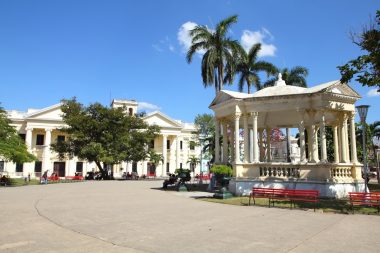Cuba, the island state in the Caribbean , has much more to offer than white dream beaches, bright sun and turquoise blue sea. This island captivates people because of its history. If you want to experience historic Cuba, you can hardly avoid a city.
Santa Clara was once an important scene in the struggle of the revolutionaries against the Batista regime. But this city is not only fascinating because of its reference to Che Guevara. Today it is a lively city with old colonial buildings, promenades and vibrant nightlife.
City with an important history
With around 240,000 inhabitants, Santa Clara is the capital of the province of Villa Clara and is very centrally located in the middle of the island. As a national transport hub, it is located on the western edge of the Escambray Mountains. The island’s capital Havana is about 280 kilometers from Santa Clara.
The history of the city began on July 15, 1689. At that time, the settlement of Cayo Nuevo was established, which quickly developed into an important place in Cuba . Later, the rapidly growing city was renamed Santa Clara. As early as the 19th century, it was an important point of the island in terms of transport.
During the time of the Cuban Revolution, Santa Clara played a decisive role. Batista sent an armored train with weapons and more than 300 soldiers to Santa Clara. But the guerrillas under Ernesto Che Guevara attacked the train and destroyed several meters of track with a bulldozer. The train derailed.
The weapons fell into the hands of the guerrilla fighters, the soldiers had to capitulate. Only a few days later, Che Guevara and Camilo Cienfuegos and their men attacked Batista’s soldiers and captured the city of Santa Clara. Shortly afterwards, Batista fled. Today, this event is considered the decisive moment of the triumph of the guerrillas.
Memories of the triumph of the “bearded men”

To this day, the Monumento al Tren Blindado is a witness to these events. The National Monument to the Cuban Revolution was created by José Delarra. Four of the train’s original cars are located in a park next to the tracks and can be visited. The bulldozer has also found a place here.
Historical photos, original weapons and various utensils immerse the visitor in the time of the revolution. They give an excellent picture of what happened at that time and are thus witnesses to an important event in the history of the island.
A very special monument in the west of the city is dedicated to the leader of the guerrillas. Comandante Ernesto Che Guevara presents himself mightily in the form of a six-metre-high bronze statue in the Plaza de la Revolución. Next to the imposing figure of the fighter are reliefs with different scenes of the Cuban guerrilla war.
Che Guevara was executed in Bolivia on October 9, 1967 and secretly buried. It was not until 1997 that his remains were discovered in Vallegrande and exhumed. With a state funeral, the bones were buried in the Monumento Memorial Che Guevara. The mortal remains of about 40 comrades in arms also rest here.
A museum is attached to the monument. Here, visitors can get a precise picture of the revolution and the Comandante. You can see equipment, his uniform, weapons and even his phone. It is hardly surprising that this monument is the most visited attraction on the island.
Cigars and colonial buildings
But Santa Clara is not only famous thanks to Che Guevara. This is where the smoking products for which the island state is known worldwide are produced. The Fábrica de Tabacos Constantino Pérez Carrodegua produces cigars of the brands Montecristo, Romeo y Julia and Partagá. These brands are among the best in Cuba and can be purchased after a guided tour in the small tobacco shop opposite.
A neo-Gothic building inevitably magically attracts the eyes of tourists. The Catedral Santa Clara de Asís was built in 1923 and impresses with its gigantic stained glass windows in the Art Deco style. The white statue of Mary seems almost magical.
From the outside, however, the Teatro la Caridad looks inconspicuous. It is one of the most important playhouses of the colonial era and hides its full beauty inside. The Santa Clara Libre Hotel is also of no interest because of its captivating appearance. Rather, it is the bullet holes of the machine guns, which are still present today, that attract attention.
Like other buildings worth seeing, the house is located around the famous Parque Vidal, the green center of the city. The later it gets, the livelier this city becomes and more and more locals and tourists populate the park. If you are in the mood for nightlife, Santa Clara is the place to be.
A city awakens
It’s not just the streets that come alive in the evening. On the roof terraces of the hotels, the bars open and welcome the night owls. Cabarets and dance performances provide nightly entertainment. Something special among all these clubs and bars is the Centro Cultural El Mejunje. A wide variety of events are offered in this cultural centre. With a lot of luck, you can even experience an extraordinary travesty show or Cuba’s drag queens here.
This makes Santa Clara an absolute must not only for those interested in history during a trip to Cuba. This city will amaze you and you should be careful not to lose your heart to Santa Clara.


